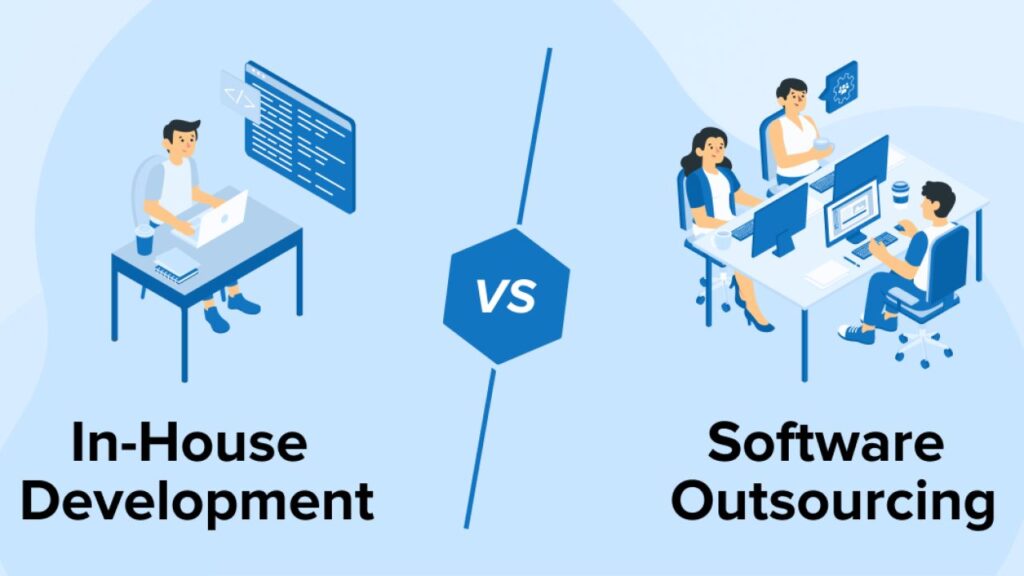In 2025, 소프트웨어 개발 continues to be a strategic pillar for digital transformation across industries. From startups building minimum viable products to enterprises launching mission-critical platforms, the question of how software is built remains fundamental. One of the most critical decisions business leaders face is whether to build an in-house development team or outsource the project to external vendors.
This article explores both models in depth, analyzing their respective advantages, disadvantages, and the contexts in which one may be preferred over the other. If your organization is planning a new software project, this guide will help you evaluate the right approach for your goals, resources, and long-term vision.
What Is In-House Development?
In-house development refers to the practice of hiring, managing, and retaining a software development team within your organization. These employees operate under your internal management structure and are fully integrated into your company’s operations, processes, and culture.
This model is typically chosen by companies seeking long-term control over product development or those whose core business is closely tied to software innovation. Building an in-house team is not simply about development; it’s an investment in internal capabilities and organizational knowledge.
Pros of In-House Development
Building an in-house development team provides companies with deeper integration between technology and strategy. For organizations that prioritize long-term product control, domain knowledge retention, and cultural alignment, this model offers several compelling advantages.
Greater Control and Oversight
With an internal team, decision-making processes are streamlined, and priorities can shift in real time without going through third-party intermediaries. This level of control ensures stronger alignment between business goals and technical execution.
Seamless Communication and Collaboration
Working in the same physical location or within close time zones fosters faster feedback loops, fewer misunderstandings, and higher team cohesion. In agile development environments where iteration speed is key, this can be a significant competitive advantage.
Stronger Cultural and Strategic Alignment
In-house developers are immersed in the company’s mission, culture, and long-term vision. Over time, they develop a nuanced understanding of the product, target users, and internal processes leading to better decision-making and product design.
Improved Quality Assurance and Technical Consistency
Internal teams are more likely to adhere to company-wide coding standards, architectural guidelines, and documentation practices. This helps maintain a clean, consistent, and scalable codebase, particularly important for large, evolving systems.
Enhanced Data Security and Regulatory Compliance
Sensitive data, proprietary algorithms, and strategic roadmaps remain within the organization. For industries bound by strict data protection laws or compliance requirements, in-house development offers superior control over security protocols and access rights.
Cons of In-House Development
Despite its advantages, in-house development comes with considerable resource commitments and organizational risks. Companies must weigh these challenges carefully, especially when operating in fast-moving or resource-constrained environments.
High Cost of Recruitment and Retention
Hiring skilled developers, particularly in mature tech markets requires significant investment in salaries, benefits, and workplace infrastructure. Retaining top talent over the long term adds further cost in the form of raises, promotions, and retention programs.
Limited Access to Specialized Talent
Companies may struggle to recruit experts in emerging or niche technologies, especially outside major tech hubs. In some cases, a lack of internal knowledge can delay innovation or reduce product competitiveness.
Longer Time to Build Teams and Launch Products
Recruitment cycles, onboarding, and team formation can take months. For projects with tight timelines or high market pressure, these delays can lead to missed opportunities or slower time-to-value.
Increased Management Overhead
Maintaining an in-house team requires strong technical leadership, HR support, and operational processes. For small or non-technical companies, this management burden can distract from core business functions.
Scalability Constraints
Unlike outsourced models, scaling in-house teams requires long-term planning, additional hiring, and resource allocation. This makes it harder to respond to short-term surges in demand or pivot rapidly to new opportunities.
What Is Outsourcing Software Development?
Outsourcing involves contracting a third-party provider to deliver software development services. These vendors can be located locally, in neighboring countries, or overseas. In 2025, outsourcing is a global, mature practice supported by robust communication platforms, development tools, and standardized delivery models.
Organizations may outsource entire projects or specific components, depending on their internal capabilities and strategic needs. Outsourcing is especially common for companies with limited technical expertise or short-term development objectives.
Pros of Outsourcing Development
Outsourcing software development remains a strategic option in 2025 for organizations seeking to balance cost, speed, and technical capabilities. When executed correctly, it offers a range of advantages that extend beyond short-term savings and contribute to long-term operational agility.
Cost Efficiency and Budget Optimization
One of the most compelling reasons companies choose to outsource is cost savings. By working with teams in countries with lower labor costs, organizations can significantly reduce expenses related to salaries, benefits, infrastructure, and recruitment. This allows businesses, particularly startups and SMEs to reallocate resources to other high impact areas such as marketing, product management, or R&D.
Faster Time-to-Market
Outsourcing vendors often have established teams, mature development workflows, and reusable code components that accelerate delivery timelines. Instead of spending weeks or months hiring and onboarding in-house developers, companies can engage a ready-to-go team and begin execution almost immediately. This is especially advantageous when launching MVPs, responding to competitive pressures, or meeting investor deadlines.
Access to Global Talent and Specialized Expertise
Outsourcing removes geographical limitations from the hiring equation. Businesses can access a global pool of talent, including specialists in emerging technologies like AI, blockchain, and IoT, as well as domain-specific expertise in fintech, healthcare, or logistics. This flexibility is invaluable when in-house talent is limited or when niche skills are required for short-term needs.
Operational Flexibility and Scalability
Outsourcing gives organizations the ability to scale development capacity up or down without long-term hiring commitments. Whether it’s expanding the team to meet a tight release schedule or reducing the workload after a product launch, vendors can adjust resource allocation with minimal friction. This level of flexibility is difficult to achieve with internal teams bound by HR constraints.
Reduced Management Burden
When working with a mature outsourcing partner, project management, QA, and technical leadership are often part of the service offering. This allows internal stakeholders to focus on core business functions such as product vision, market strategy, or customer engagement while the vendor handles day-to-day development tasks. For companies with limited technical leadership, this can significantly reduce operational overhead.
Cons of Outsourcing Development
While outsourcing provides flexibility and cost savings, it also introduces several potential challenges that may affect project execution, quality, and collaboration. Understanding these drawbacks is essential to mitigating risks and setting realistic expectations from the outset.
Reduced Control Over Project Execution
When you delegate development to an external team, you inevitably relinquish a certain level of direct oversight. The outsourced team operates outside your organizational structure, which can lead to a disconnect between your internal strategic objectives and the implementation on the ground. Decision-making may be slower, especially if approvals and iterations must pass through account managers or project leads unfamiliar with your internal dynamics.
Communication and Coordination Challenges
Outsourcing often involves working across time zones, languages, and cultural contexts. These differences can result in delayed responses, misinterpreted requirements, or misaligned expectations, especially in fast-paced or highly iterative projects. Even with strong communication tools and protocols, the potential for information gaps remains, particularly when complex tasks require real-time clarification.
Security and Confidentiality Risks
Sharing source code, system architecture, or user data with external partners introduces cybersecurity and compliance risks. While reputable vendors implement robust security measures and sign NDAs, sensitive projects in regulated industries (e.g., healthcare, finance) may still face elevated exposure. Organizations must assess the vendor’s data handling practices, infrastructure security, and legal frameworks before engagement.
Quality Assurance Variability
The quality of outsourced software development can vary significantly depending on the vendor’s expertise, team composition, and development standards. Without close supervision or clear performance benchmarks, there is a risk of receiving poorly documented, buggy, or non-scalable code. Additionally, if the outsourced team lacks long-term commitment to the product, technical debt can accumulate over time.
Dependency and Knowledge Retention Issues
Over-reliance on external providers can create long-term operational risks. If critical product knowledge resides solely with the vendor, transitions such as switching providers or bringing development back in-house can be difficult and costly. Without proper documentation and knowledge transfer protocols, organizations may find themselves locked into suboptimal relationships or unable to iterate independently.
Making the Right Choice: In-House vs. Outsourcing
There is no universal answer to the question of whether in-house or outsourced development is better. The right choice depends on your organization’s objectives, available resources, risk tolerance, and long-term plans.
Choose in-house development if:
- Your software is central to your product or competitive advantage
- You require complete control over the development lifecycle
- Data security and regulatory compliance are critical
- You’re building a team for long-term, continuous development
Choose outsourcing if:
- You need to launch quickly or work within a fixed budget
- You lack in-house technical expertise
- Your project is short-term or exploratory
- You want to reduce overhead and focus internal efforts elsewhere
In many cases, a hybrid approach is ideal. Companies may maintain a small in-house team for strategic planning and oversight, while outsourcing specialized functions such as frontend development, QA, or DevOps. This allows for flexibility without sacrificing control.
자세히 보기 When to Hire In House and When to Outsource
Final Thoughts
There is no single perfect approach to software development. Building an in-house team gives you stronger control, better team alignment, and easier communication. It is a great choice for companies aiming for long-term innovation and ownership. On the other hand, outsourcing helps you access expert talent quickly, reduce costs, and scale faster, which is ideal for fast-moving projects or limited resources.
The right decision depends on your business needs, goals, and capacity. At 스핑크스, we support both approaches by providing tailored development services that combine technical expertise with flexibility. Whether you build in-house or outsource, we are here to help you grow with confidence.




CEO - Son Le
기타 블로그
블로그
Hybrid Cloud 2025: Enterprise Guide to Modern IT
Hybrid cloud has become a core pillar of enterprise IT modernization as organizations seek architectures that balance security, performance, and scalability. In 2025, the hybrid model allows businesses to protect sensitive workloads in private environments while unlocking innovation, automation, and AI capabilities through public cloud platforms. This shift reflects a...
자세히 보기블로그
AI Driving Innovation: Key Impacts, Challenges and Market Trends
Artificial Intelligence is rapidly moving from a supportive capability to a central engine of innovation across modern enterprises. Its advancements in automation, generative modeling and real time analytics are redefining how organizations operate, scale and deliver value. As AI becomes embedded into products, workflows and strategic decisions, it is reshaping...
자세히 보기블로그
Top 10 Countries for IT Outsourcing in 2026
IT outsourcing is becoming an increasingly popular strategy as businesses worldwide seek to accelerate digital transformation, reduce operational costs, and access specialized tech talent. With the rapid growth of cloud computing, AI, and software development demands, more companies are turning to global partners to stay competitive and scale efficiently. In...
자세히 보기기타 블로그
서비스
IoT 개발
SphinX는 최첨단 IoT 개발 서비스를 제공하여 디바이스를 원활하게 연결하고 혁신적인 솔루션을 제공합니다.
테마서비스
블록체인 개발
우리는 신뢰할 수 있고 안전한 블록체인 기술을 처음부터 설계하는 데 매우 능숙하며, ...
테마서비스
ERP 및 CRM 개발
필요한 ERP & CRM 개발 서비스! 비즈니스 프로세스 간소화 및 조직 효율성 향상....
테마기타 블로그
서비스
IoT 개발
SphinX는 최첨단 IoT 개발 서비스를 제공하여 디바이스를 원활하게 연결하고 혁신적인 솔루션을 제공합니다.
테마서비스
블록체인 개발
우리는 신뢰할 수 있고 안전한 블록체인 기술을 처음부터 설계하는 데 매우 능숙하며, ...
테마서비스
ERP 및 CRM 개발
필요한 ERP & CRM 개발 서비스! 비즈니스 프로세스 간소화 및 조직 효율성 향상....
테마